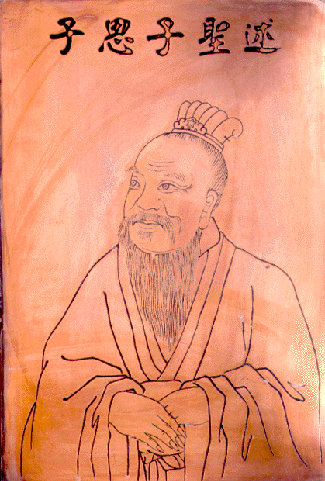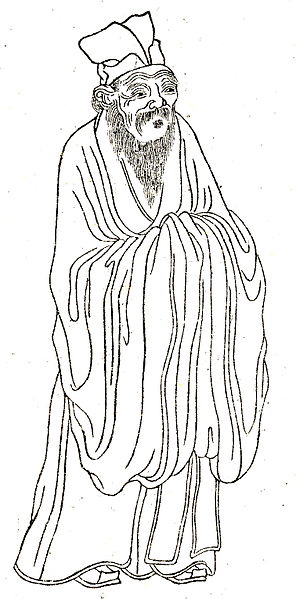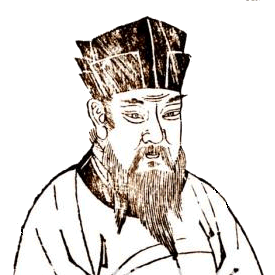<Back to Index>
This page is sponsored by:
PAGE SPONSOR

Zisi (Chinese: 子思; ca. 481 – 402 BCE), born Kong Ji (孔伋), was a Chinese philosopher. Zisi, who was the only grandson of Confucius, supposedly taught Mencius and wrote the Doctrine of the Mean. He is honorifically called Zisizi (子思子, "Master Zisi").
Where his grandfather began to distinguish between true and supposed knowledge, Zisi proceeded upon meditations on the relativity in human knowledge of the universe. He attempted to analyze as many types of action as possible, and believed that wise people who are conscious of their moral and intellectual duties can copy the reality of the universe into themselves.
On par with Mengzi, Zi Si is attacked by Xunzi in his famous "Against Twelve Masters" chapter. The target of Xunzi's attack is the Wuxing teaching. Extant version of the book of the same name is ascribed to Zi Si.


Shao Yong (Chinese: 邵雍; 1011 – 1077), courtesy name Yaofu (堯夫), named Shào Kāngjié (邵康節) after death, was a Song Dynasty Chinese philosopher, cosmologist, poet and historian who greatly influenced the development of Neo - Confucianism in China.
Shao
is considered one of the most learned men of his time. Unlike most men
of such stature in his society, Shao avoided governmental positions his
entire life, but his influence was no less substantial. He wrote an
influential treatise on cosmogony, the Huangji Jingshi (皇極經世, Book of supreme world ordering principles).
Shao's ancestors were from Fanyang. He was born in 1011 in an area known as Hengzhang county (衡漳, now Anyang, Henan) to Shao Gu (邵古, 986 – 1064) and Lady Li (李氏, d. 1032 or 1033). Shao's mother, Li, was an extremely devout practitioner of Buddhism. This link with Buddhism proved to be a major influence on Shao's thought throughout his life.
Shao Yong's first teacher was Shao Gu, his father. This was common practice in the familial environment of China at the time. Shao Gu was a scholar in philology and his influence can be discerned in Shao's literary works. Guided by his father, he studied the Six Confucian classics intensively at a young age. Shao also sought out the scholarship of private schools, many of which were run by monks and heavily influenced by Buddhism.
Around 1020, the Shao family moved to Gongcheng county (now Xinxiang, Henan).
Shortly after his mother's death in 1032 or 1033. Shao met his most
important teacher, Li Zhicai (李之才). Li was a former pupil of ancient
prose specialist Mu Xiu (穆修, 979 – 1032). Under Mu Xiu, Li had studied the I Ching extensively.
Shao was a member of a group of thinkers who gathered in Luoyang toward the last three decades of the 11th century. This group had two primary objectives. One of these was to draw parallels between their own streams of thought and that of Confucianism as understood by Mencius.
Secondly, the men set out to undermine any links, real or otherwise, between 4th century Confucianism and what they viewed as inferior philosophical schools of thinking, namely Buddhism and Taoism. Other loosely connected members of this so-called network of thinkers include: Cheng Yi, Zhang Zai, Cheng Hao (程顥, 1032 – 1085) and Zhou Dunyi. Central to each of these men was the ancient text I Ching, which each had studied closely. The way in which Shao studied this ancient text, however, differed from the other members.
During the Song Dynasty, there were two main approaches in I Ching studies. Together with the majority of scholars, the other members of the group took the yili xue (義 理學, "principle study") approach, which was based on literalistic and moralistic concepts. The other approach, taken by Shao alone, was the xiangshu xue (象數學, "image - number study") approach, which was based much more on iconographic and cosmological concepts.
Shao
Yong also edited the "Tai Hsuan Jing" by Yang Hsiung (10 AD).
Influenced by the Base 3 number system found in the Tai Hsuan, Shao Yong then set the Hexagrams of the I Ching into
a binary order (the Fu Hsi Ordering). This in turn influence Leibniz
and his thinking on binary arithmetic, and in turn the language of
modern computers.
Shao is also famous for his poetry and for his interest in the game of Go (wéiqí). He wrote a Great Ode to Watching Wéiqí (觀棋大吟), one of the longest surviving classical Chinese poems, as well as a Long Ode to Watching Wéiqí (觀棋長吟), which is translated below.
- Long Ode to Watching Weiqi
 | In a quiet courtyard in the spring, with evening's light filtering through the leaves, |  |
Shao Yong | ||